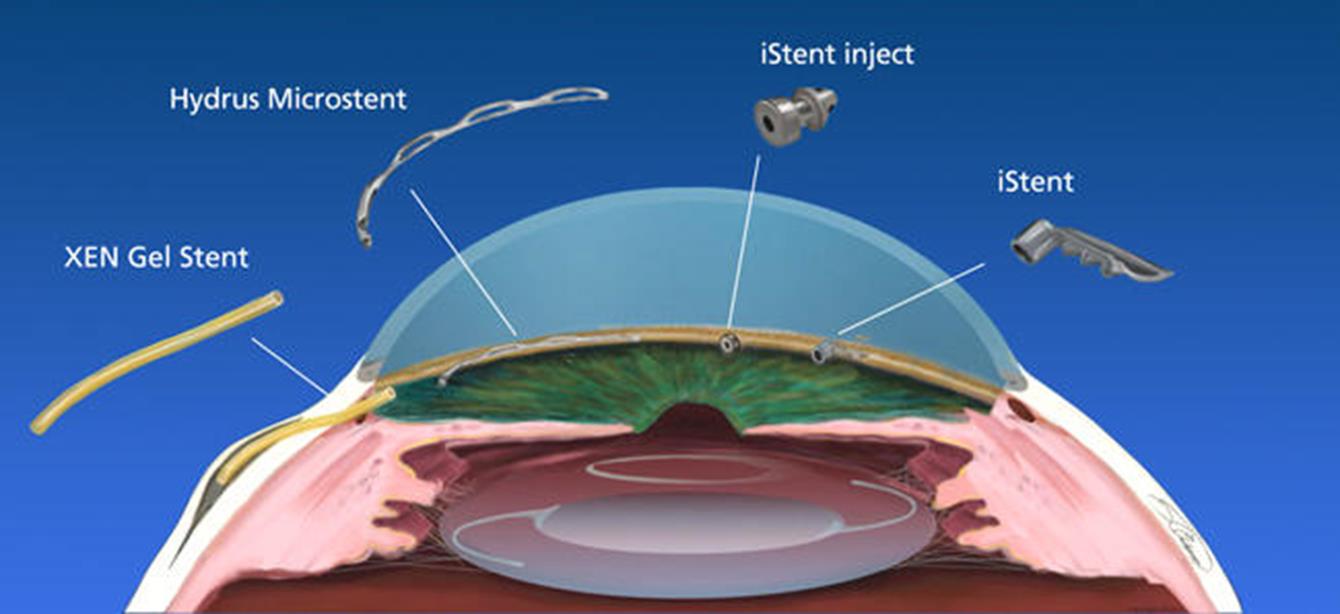Minimally Invasive Glaucoma Surgery

Minimally Invasive Glaucoma Surgery (MIGS) - Image source: www.glaucoma.org
MIGS are a group of operations that have been developed to reduce complications and recovery time following surgery. Most use microscopic equipment and small shunts throughout the surgery. These are often combined with cataract surgeries. Mr Agarwal will speak to you about these if he thinks they may be a good fit for your situation.
MIGS are designed with the following principles in mind;
- Improve the flow of aqueous humour (fluid in the front portion of the eye) though the trabecular meshwork (drainage network of the eye).
- Reliably reduce intraocular pressure.
- Minimise trauma and changes to the natural anatomy of the eye.
- Extremely safe.
- Quick recovery with reduced follow-up.
Most minimally invasive glaucoma surgeries are quick when compared to a traditional glaucoma surgery, and are generally around 30 minutes. The surgery is typically done under either local or may be under general anaesthetic. The procedure is usually done as a day case procedure. We also consider what support you have at home.
After the surgery you may notice some redness and swelling of the eye and lids. Immediately following the surgery, you will have a patch on the eye and you should wear this at night to protect the eye while you sleep.
Blurring of vision
You may find that your vision is blurred for the first 1-2 weeks after the operation, until the operation site is healed. The operation will not restore any sight you have already lost, it is to save the sight you have.
Discomfort in the eye
Mild pain and discomfort are common in the post-operative period, this is partly due to the surgery itself. The eye should return to a normal feeling after approximately 1 month.
Eye drops
You will be required to use eyedrops to help with the healing process and may still need to use your glaucoma drops. Mr Agarwal will provide instructions on what drops to use.
It is important to continue any eye drops to the UNOPERATED eye unless Mr Agarwal tells you otherwise. Use drops in the operated eye after the surgery as directed by Mr Agarwal.
The eye will remain numb throughout the surgery. If you are aware of any pain, please let Mr Agarwal know, as this is unusual. The initial numbing of the eye is done with a drop followed by an injection. You may be aware of slight discomfort and pressure as the anaesthetic is delivered.
Throughout the surgery you may see bright lights and hear people talking. Only your eye will be visible to Mr Agarwal, the remainder of your face will be covered with a sterile drape to keep the operation sterile.
Complications follow a MIGS is rare.
As with any surgery, the risk of infection post operatively is present (1 in 1000). Inflammation and requirement for a second surgery are also possible with MIGS.
Severe complications are rare; however, can happen if the pressure in the eye drops very low or too quickly. Bleeding is the most serious risk and occurs in less than 1 in 1000 patients. Mr Agarwal takes every precaution to avoid this however it is often unpredictable.
Some MIGS create the formation of a bleb, a blister like area of fluid in the upper layers of the sclera (white of the eye) underneath the top eyelid.
A MIGS may not completely lower the eye pressure to the target level and drops may still be required.
Although proven to be safe and approved treatments, MIGS are relatively new and new data is constantly being collected to influence use and their indication. This means that unexpected complications may occur many years after implantation.
Do…
Wear your glasses throughout the day as normal, if you have them.
Continue to read and watch TV.
Wear sunglasses to reduce light sensitivity, if needed.
Wash you hands before inserting drops.
Wear an eye shield at night for as long as recommended by Mr Agarwal.
Keep to a routine with drop insertion. If you have a smart phone, there are apps you can download to help you with this or many patients make a chart.
Arrange to take some time off work if you’re working, this can depend on the individual and type of work required.
Ask any questions you may have.
Don’t…
Wear contact lenses until cleared by Mr Agarwal.
Wear eye make-up for at least 2 weeks ideally 4 weeks following surgery.
Touch the tip of the eye drop bottle with your fingers or to your eye.
Bend over, stain or undertake strenuous activities like weight lifting running, biking or inversions in yoga.
Put pressure on your eye for at least four weeks, this will aid in the healing process.
Update your glasses within the first 3 months of surgery.
Be afraid to ask questions.
As a MIGS procedure, the OMNI® Surgical System helps unclog pressure buildup in the eye by removing unnecessary blockages.
Accuracy
While care has been taken to compile accurate information and to keep it up to date, Mr Agarwal cannot guarantee its correctness and completeness. The information provided in this information sheet is designed to support care and is not a substitute for professional healthcare advice, by a qualified doctor or other healthcare professional, which will be tailored to a patient’s individual circumstances.
